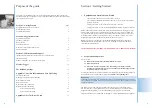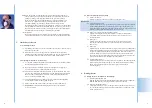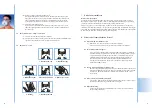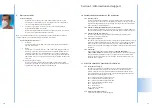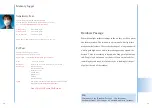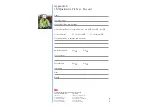
TIP: Screw the cap fi rmly on the bottle to prevent saccharin solution leaking out
and crystallising as a white powder around the cap. In particular, try and avoid
getting any of the powder into the nebuliser or it may become blocked.
If this occurs during a fi t test then ideally have a spare one available to use.
Otherwise you will have to halt the test, wash the nebuliser using the ‘pin’
provided to dislodge any blockages, and then start the test again from
the beginning. Finally, avoid storing the solutions in a cold place as the saccharin
can crystallise into a lump inside the bottle. If this occurs, you may have to leave
the bottle in warm water for a while to dissolve the saccharin back into solution.
The bitter solution is less prone to crystallising out of solution.
(iii)
Respirators
Have enough samples of each respirator you are testing (together with different
sizes when applicable). One for each person and a few spares should be enough.
5. On the day of the test
5.1 Assembling the hood
(i) The training video on how to use the Fit Test Kit shows a simple and easy way to
fi t the hood to the collar.
(ii) Make a 10cm ‘gap’ between the persons face and the inside of the hood by
pulling apart the front and back of the hood at the top. You can clip together the
two press-studs on the top corners of the hood to hold it in this shape.
5.2 Preparing the nebulisers – Practical tips
(i) Use the foam block provided in the kit with the round holes as a holder to stand
the nebulisers upright and ready for use.
(ii) Don’t pour in too much solution. A teaspoon is enough for several people.
A quarter teaspoon is more than enough for one person.
(iii) Each nebuliser is marked ‘Sensitivity Solution’ or ‘Fit Test Solution’. DO NOT
put the wrong solution into the nebuliser or you risk using the wrong solution in
the tests. (The two solutions have different concentrations and should not be
mixed or confused with each other).
(iv) Check BOTH nebulisers are working by spraying against a dark background.
You should see a fi ne mist coming from the spout.
(v) Wash your hands afterwards to reduce the risk of surface contamination.
(vi) REMEMBER to remove both plastic plugs when you use the nebuliser
(or it won’t work!).
5.3 What to tell the person being tested
(i) Purpose
of
the
Test
Explain the purpose of the test and what you want them to do.
KEYPOINT:
(ii) Follow instructions given
Explain that the test is very rigorous and it is possible to taste very tiny amounts
of the solution should they get inside the respirator. They should follow your
instructions precisely and should not talk until asked to do so. They need to avoid
laughing or doing anything different from the test protocol.
(iii) If they wear other Personal Protection Equipment
Explain that during the Fit Test they should wear whatever other PPE they
would normally wear when using the respirator, such as safety eyewear or
normal spectacles.
(iv) If they pass
Explain that if they pass, this result is specifi c to this particular respirator
and they should not use another type or model unless they are fi t tested on
that one too.
(v) If they fail
Explain they can be tested on the same respirator a second time even though they
failed at the fi rst attempt. This is because failures are often a result of not taking
enough care during fi tting. If they fail twice, then they should not see this as a
failure on their part. It is just an indication that the respirator tested has been
shown not to fi t them well enough and an alternative must now be tried in order
to
fi nd a model that will provide them with an adequate fi t.
(vi) Washing hands and face
Explain the importance of avoiding a false test result due to trace amounts of the
solution getting into their mouth. This is why they will be asked to wash their
hands, face and lips before the fi t test stage begins and to keep these
clean
throughout.
6. During the test
6.1 During the Tests – Reminders & Practical Tips
(i) Breathing through the mouth
Remind the person to breathe through their mouth with their tongue slightly out.
Remind them that they are trying to taste the solution, not smell it.
(ii) Regularly check the nebuliser
Frequently check that you can see the spray entering the hood. If the mist can’t
be seen then the nebuliser may have become blocked and you will need to take
action (see para 4.2 (i).)
7
6


